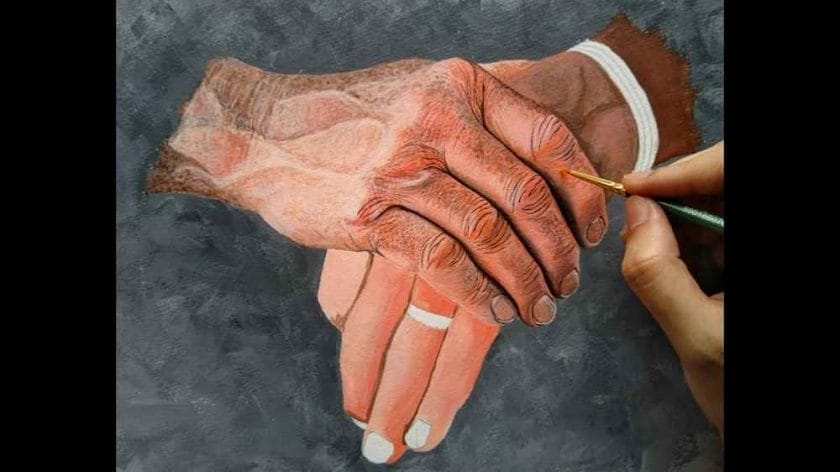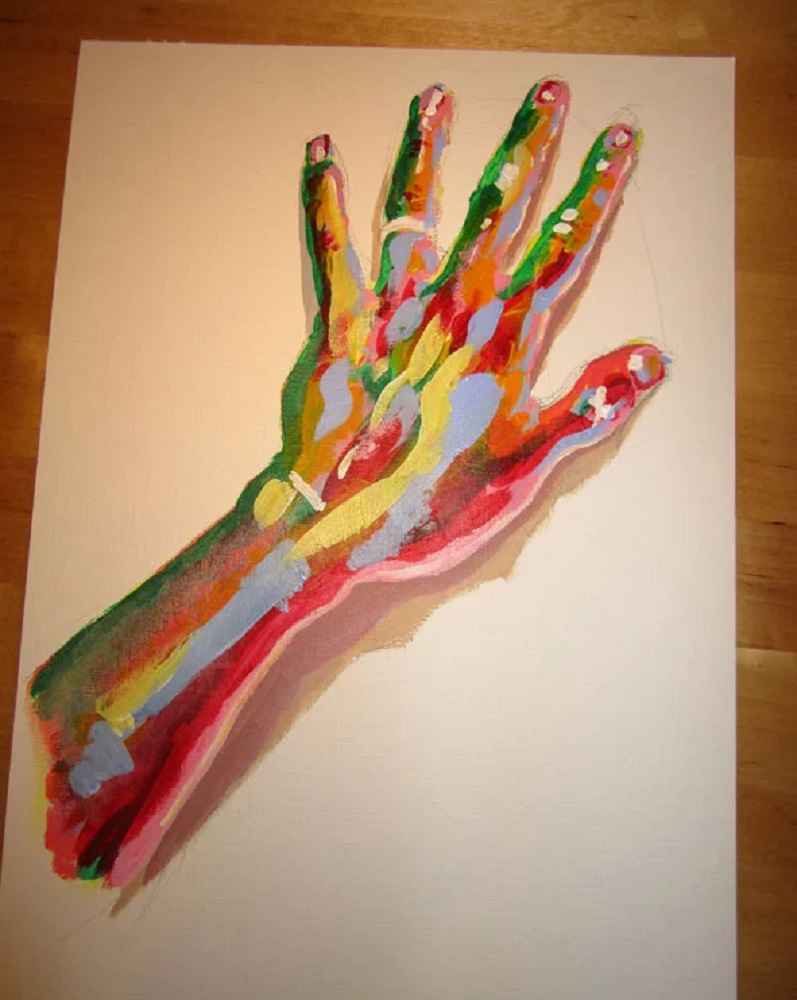Painting with acrylics can be rewarding, easy and fun. Acrylic paints are a popular choice for painting hands due to their fast drying time, versatility, and ability to create many different styles of art.
Whether you are an experienced painter or just starting out, there is always something new to learn and explore when it comes to capturing the intricacies and expressions of the human hand.
In this comprehensive article, we will cover everything you need to know about painting hands with acrylic.
Essential Materials for Painting Hands with Acrylic
Before you start painting, it is important to gather all of the necessary materials. Here are the basic supplies you will need to get started:
- Canvas or Painting Surface: A good quality canvas or painting surface is essential for creating a durable and long-lasting piece of art.
- Acrylic Paints: Acrylic paints come in a wide range of colors, so you can mix and match to create the perfect shades for your painting.
- Brushes: A variety of brushes, including round, flat, and filbert brushes, will give you the flexibility to create different textures and effects in your painting.
- Palette: A palette is used to mix and store your paint, so you can easily access the colors you need.
- Water Container: Keeping a container of water handy is essential for cleaning your brushes and thinning out your paint as needed.
- Easel (Optional): An easel can be helpful for holding your canvas at a comfortable angle, but is not necessary for painting hands.
Preparation for Painting
Before you start painting, it is important to properly prepare both yourself and your workspace. Doing the following can help you prepare your workspace for painting:
- Choosing the Right Reference Image: A good reference image is essential for painting hands, so it is important to choose one that has the right level of detail and is clear and well-lit.
- Setting up the Painting Area: Find a well-lit area to paint in and make sure you have a comfortable seat and a flat surface to work on.
- Mixing Paint Colors: To achieve the best results when painting hands, it is important to mix your paint colors carefully to get the right shades and hues.
Step-by-Step Guide to Painting Hands with Acrylic
Once you have your materials and workspace set up, it is time to start painting. Here is a step-by-step guide to help you create a detailed and lifelike painting of hands using acrylic paints:
Sketching the Outline of the Hands:
Start by sketching the basic outline of the hands onto your canvas. This will give you a reference to work from and help you ensure that the proportions and placement of the hands are correct.
Painting the Shadows:
Once you have your outline sketched, it is time to start adding color to your painting. Begin by painting the shadows and darker areas of the hands, using a darker shade of paint and a smaller brush.
Adding Dimension to the Hands:
Next, build up the dimension and form of the hands by adding in lighter colors and highlighting areas where the light would hit.
Final Touches and Details:
Finally, add any final touches and details to your painting, such as highlights, shadows, and textural elements. This is also a good time to step back and assess the overall composition of your painting, making any necessary adjustments before it is complete.
Tips and Tricks for Painting Hands with Acrylic
While painting hands with acrylic can be a challenging process, there are several tips and tricks that can help make it easier and more enjoyable. Here are some of the best:
Blend Colors:
To create a smooth and lifelike painting, it is important to blend your colors carefully, using a dry brush or blending tool to soften the edges and create a natural-looking transition between different shades.
Create Textures:
Adding textures to your painting, such as wrinkles and creases in the skin, can help bring it to life and make it look more realistic. Experiment with different brushes and techniques to find the right look for your painting.
Use Glazing Techniques:
Glazing is a technique where you layer thin washes of transparent paint over one another to build up depth and color. This can be a great way to add subtle color variations and depth to your painting, especially when painting skin.
Experiment with Different Brush Sizes:
Different brush sizes can produce different effects, so it is important to experiment with a variety of sizes to find the right one for your painting.
A larger brush can be great for covering large areas quickly, while a smaller brush is ideal for adding fine details and textures.

Common Mistakes and How to Avoid Them
Painting hands with acrylic can be a tricky process, and it is easy to make mistakes along the way. Here are some of the most common mistakes to avoid:
Overworking the Paint:
Overworking the paint can result in a muddy and unappealing painting, so it is important to work quickly and efficiently, blending your colors carefully and allowing the paint to dry fully between each layer.
Not Using Enough Paint:
Not using enough paint can result in a flat and lifeless painting, so it is important to use enough paint to build up the form and texture of the hands.
Improperly Blending Colors:
Improperly blending colors can result in a harsh and unnatural-looking painting, so it is important to blend your colors carefully and use a variety of brushes and techniques to create a smooth and lifelike result.
Using the Wrong Brushes:
Using the wrong brushes can result in an uneven or poorly defined painting, so it is important to experiment with different brush types and sizes to find the ones that work best for you.

Conclusion
Painting hands with acrylic can be a challenging and rewarding experience, and with the right tools and techniques, anyone can create a beautiful and detailed painting.
Whether you are just starting out or are an experienced painter, remember to have fun, experiment with different materials and techniques, and be patient and persistent in your practice.
With time and experience, you will be able to create stunning and lifelike paintings that truly capture the beauty and expression of the human hand.
Frequently Asked Questions about Painting Hands with Acrylic
What type of canvas is best for painting hands with acrylic?
A high-quality, acid-free canvas or heavy watercolor paper is best for painting hands with acrylic.
A canvas with a medium to heavy texture is ideal, as it can help you build up the form and texture of the hands, but a smoother canvas can also work well for more delicate or detailed paintings.
Is it necessary to use a palette knife when painting hands with acrylic?
No, it is not necessary to use a palette knife when painting hands with acrylic. However, using a palette knife can be a great way to build up texture and add depth to your painting, especially when blending and layering different colors.
How do I keep my acrylic paint from drying too quickly?
To keep your acrylic paint from drying too quickly, you can add a retarder medium to your paint, or spray your canvas or palette with a fixative spray.
You can also work in a well-ventilated area or use a humidifier to add moisture to the air, which can help slow down the drying process.
Can I use watercolor techniques when painting hands with acrylic?
Yes, you can use watercolor techniques when painting hands with acrylic, such as glazing and wet-on-wet painting.
Acrylics have a different consistency and drying time than watercolors, so it is important to work quickly and adjust your techniques accordingly.
Can I use oil paint techniques when painting hands with acrylic?
Yes, you can use oil paint techniques when painting hands with acrylic, such as blending and layering. However, acrylics have a different consistency and drying time than oils, so it is important to work quickly and adjust your techniques accordingly.
It is also important to note that acrylics do not have the same luminous quality as oils, so the final result may be slightly different.
